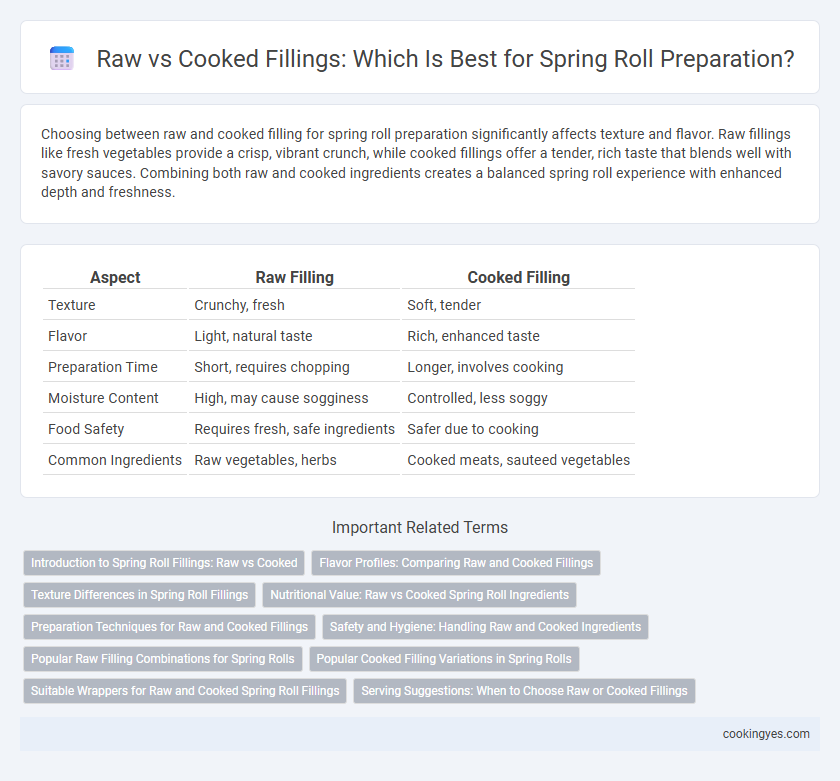Choosing between raw and cooked filling for spring roll preparation significantly affects texture and flavor. Raw fillings like fresh vegetables provide a crisp, vibrant crunch, while cooked fillings offer a tender, rich taste that blends well with savory sauces. Combining both raw and cooked ingredients creates a balanced spring roll experience with enhanced depth and freshness.
Table of Comparison
| Aspect | Raw Filling | Cooked Filling |
|---|---|---|
| Texture | Crunchy, fresh | Soft, tender |
| Flavor | Light, natural taste | Rich, enhanced taste |
| Preparation Time | Short, requires chopping | Longer, involves cooking |
| Moisture Content | High, may cause sogginess | Controlled, less soggy |
| Food Safety | Requires fresh, safe ingredients | Safer due to cooking |
| Common Ingredients | Raw vegetables, herbs | Cooked meats, sauteed vegetables |
Introduction to Spring Roll Fillings: Raw vs Cooked
Spring roll fillings can be categorized into raw and cooked ingredients, each offering distinct textures and flavors essential for an authentic culinary experience. Raw fillings often include fresh vegetables like lettuce, carrots, and herbs that provide a crisp, refreshing contrast. Cooked fillings, such as sauteed meats, shrimp, or mushrooms, contribute rich, savory flavors and a tender texture that complement the overall balance of the spring roll.
Flavor Profiles: Comparing Raw and Cooked Fillings
Raw fillings in spring rolls offer a fresh, crisp texture with vibrant, natural flavors from ingredients like julienned vegetables and herbs, enhancing the light and refreshing taste profile. Cooked fillings, such as stir-fried meats and sauteed vegetables, provide deeper, richer umami notes and a more robust flavor complexity due to caramelization and seasoning. Balancing raw and cooked elements can create a harmonious spring roll with layers of texture and flavor intensity.
Texture Differences in Spring Roll Fillings
Raw spring roll fillings offer a crisp and fresh texture, often featuring ingredients like shredded lettuce, julienned carrots, and fresh herbs that provide a light crunch. Cooked fillings, such as sauteed mushrooms, minced meat, or steamed vegetables, present a softer, more tender texture that melds flavors together for a rich mouthfeel. Combining raw and cooked components in spring rolls creates a balanced contrast, enhancing the overall eating experience by mixing crunchy and smooth textures.
Nutritional Value: Raw vs Cooked Spring Roll Ingredients
Raw spring roll fillings retain higher levels of heat-sensitive vitamins such as vitamin C and folate, which can be diminished during cooking processes. Cooked fillings often enhance the bioavailability of certain nutrients like beta-carotene and antioxidants found in vegetables. Balancing raw and cooked ingredients in spring rolls maximizes both nutritional value and flavor absorption.
Preparation Techniques for Raw and Cooked Fillings
Raw fillings for spring rolls often include fresh vegetables like julienned carrots, cucumbers, and lettuce, which require precise washing, drying, and cutting techniques to maintain crispness and prevent sogginess. Cooked fillings, such as sauteed mushrooms, shrimp, or shredded chicken, demand careful seasoning and cooling before rolling to ensure optimal texture and flavor integration without compromising the rice paper's structural integrity. Mastering preparation techniques for both raw and cooked fillings enhances the overall balance between freshness and savory richness, delivering a perfectly textured spring roll.
Safety and Hygiene: Handling Raw and Cooked Ingredients
Handling raw and cooked fillings separately is crucial for spring roll safety and hygiene to prevent cross-contamination and foodborne illnesses. Use different utensils and cutting boards for raw vegetables, meats, and cooked ingredients, and ensure thorough cooking of meat fillings to kill harmful bacteria. Proper washing of raw vegetables and maintaining cold storage for perishable items further enhance the safety and quality of spring roll fillings.
Popular Raw Filling Combinations for Spring Rolls
Popular raw filling combinations for spring rolls include fresh herbs like cilantro and mint, julienned vegetables such as carrots, cucumber, and bell peppers, and protein options like cooked shrimp or tofu for added texture and flavor contrast. These ingredients retain their natural crunch and vibrant colors, enhancing the roll's visual appeal and providing a refreshing taste. Raw fillings offer a nutritious, crisp bite that balances well with dipping sauces like hoisin or peanut sauce.
Popular Cooked Filling Variations in Spring Rolls
Popular cooked filling variations for spring rolls include shredded chicken, sauteed shrimp, and stir-fried vegetables like cabbage, carrots, and mushrooms. These ingredients are often seasoned with soy sauce, garlic, and ginger to enhance flavor and ensure the filling is tender and juicy. Using cooked fillings ensures food safety and delivers a consistent taste experience in every bite.
Suitable Wrappers for Raw and Cooked Spring Roll Fillings
Spring roll wrappers made from rice paper are ideal for raw fillings, offering a delicate texture that complements fresh vegetables and herbs without requiring cooking. For cooked fillings containing sauteed meats or vegetables, wheat-based wrappers provide a sturdy, elastic texture that holds up well during frying or steaming. Choosing the appropriate wrapper enhances the structural integrity and flavor harmony of spring rolls with varying fillings.
Serving Suggestions: When to Choose Raw or Cooked Fillings
Raw fillings in spring rolls, such as fresh vegetables and herbs, provide a crisp texture and vibrant flavor ideal for cold or room-temperature servings, especially in summer or as light appetizers. Cooked fillings, including sauteed meats, mushrooms, or seafood, offer a richer, more savory profile suited for warm spring rolls or fried versions, enhancing the overall depth of taste. Choosing between raw or cooked fillings depends on the desired texture, flavor intensity, and serving temperature, with raw best for fresh, healthy bites and cooked preferred for hearty, comforting options.
Raw vs Cooked filling for Spring roll preparation Infographic

 cookingyes.com
cookingyes.com